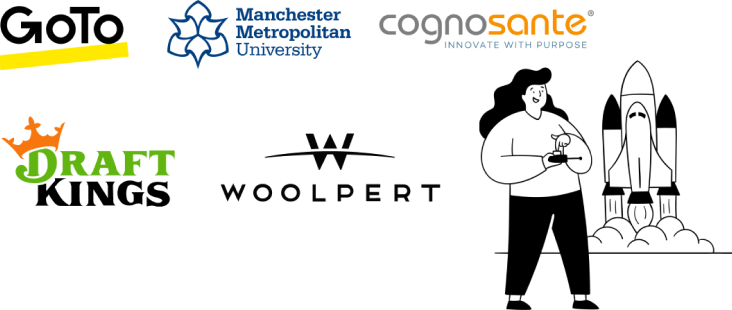
Now and then, employees need information to get work done.Enterprise search for knowledge discovery and access is imperative for businesses of all sizes.
Service or help desks are most organizations' sole platform for finding information. Unfortunately, broken or unsophisticated technologies make finding information difficult for users.
A legacy service desk is at the root of this problem, needing more essential features to help with information discovery and access for employees to work.
Enterprise search and knowledge discovery are inconsistent with most organizations' standards, forcing employees to struggle with the most common IT or HR support issues. So, it is common to have operational efficiency and employee disengagement issues.
Workativ’s conversational AI, which combines the features of Generative AI, facilitates faster collaborations and communications for knowledge discovery with great flexibility and helps improve operations efficiency and business resilience.
Our eBook emphasizes the economic impact of your investment in conversational AI in the long run and better cost optimization, which you otherwise fail to realize with the legacy approach, incurring higher maintenance costs and productivity losses.
To help you understand the benefits of conversational AI and Generative AI for employee productivity and operational efficiency, our comprehensive analysis of costs being wasted towards maintaining a legacy system gives you a clear understanding of where you are spending extra money, yet not leveraging benefits as your business needs to grow.
Workativ as a conversational AI is a significant impetus for enterprise needs to drive operational efficiency through improved employee communications and collaborations, helping them find crucial daily information to get work and reduce the cost of managing service desks.
1. The current state of employee support (challenges)
Employee productivity losses and bottom-line implications driven by ticketing systems or old and legacy service desk systems are often overlooked by business leaders.
Businesses have disparate tools placed at different touchpoints for their employees to enable them to raise service or help requests.
Should requests have real-time responses, employees can expect rapid resolution of issues and increased uptime.
Incognizance of the efficacy of conversational AI and self-service preferences for traditional ITSM tools does not help but throw up more challenges.
The cost of employee productivity loss or downtime companies experience happens for inefficient tools. It is a double blow on the company's balance sheet.
Though the report involves unified communications systems, we can relate this to an inefficient service desk or a traditional service desk operations management that hinges upon emails, phone calls, or intranets. Being multichannel and not omnichannel, these disparate tools do not provide integrated views of either ticket escalation or lifecycle management, causing rising maintenance costs for HR and IT support and leading to employee dissatisfaction.
In reality, service requests are a lengthy process compared to incident requests, which combine to add to a weighted average cost per ticket.
The figure above describes the benchmarking ranges for CPT for North American Service Desks.
2. Conversational AI X Generative AI-powered chat interface
Elimination of manual intervention for service requests and fostering operational efficiency at scale
Manual help for problem-solving can be intimidating because the assistance employees want may not turn up on a particular day. Unfortunately, it can take another day or two for the help to come.
Auto-resolutions of service requests through conversational AI and Generative AI are productive and transformative for employees.
A conversational AI and Generative AI solution can define a chatbot platform as more sophisticated and advanced than a regular chatbot. It gives answers to natural language queries by detecting the context and intent of a query rather than answering from predefined conversation templates.
Workativ redefines workplace automation for common employee queries.
Workativ’s conversational AI combines Generative AI in its interface for users to make finding information fast and quick without needing additional effort to read through long articles. It also provides real-time auto-resolution capabilities for users to solve problems instantly.
Companies can empower employees to surface information regarding common service requests and resolve them at scale while ensuring uptime.
Answers to common employee questions such as password reset, account unlock, VPN settings, and many more are real-time and autonomous for employees who need no human interventions or wait for the ticket to escalate to move to the next tier for resolution.
Employee flexibility on Workativ
Organization flexibility with Workativ
3. Key Features and Capabilities of Workativ
Exploring Workativ’s cutting-edge technology
Workativ is built on the technological advancement of Artificial Intelligence, Machine Learning, Large Language Models, or Generative AI. Workativ is not limited to predefined conversations; it can answer any questions.
All these features and technology advancements have a solid focus for Workativ that aims to enrich the user experience by improving problem-solving for everyday workplace issues.
4. The economic impact of Workativ on organizations
Employee engagement and cost savings enabled by Workativ
Workativ's conversational AI platform aims to help businesses introduce digital transformation or modernize their current processes, which are otherwise unattainable due to the high costs associated with tools and technologies and critical digital transformation barriers.
With a no-code chatbot builder, AI or Generative AI engine, prebuilt conversation templates, easy app integrations, and other significant features, Workativ helps businesses streamline processes through automation, remove manual dependency and continuous repetitive task handling and costly mistakes, and promote a collaborative culture to build a thriving business by enhancing employee experience and engagement and customer service delivery.
Workativ continues to provide scale to employee support no matter how many employees increase through its real-time knowledge discovery service for autonomous problem solving for businesses. High-tech firms, IT consultancy firms, manufacturing firms, sports goods-producing firms, and many others have brought efficient and effective modernization to their existing processes and automate for true digital transformation at half a cost.
Overall: Very positive experience. We are able to grow the bot based on our internal needs. The cost and support can’t be beat for all the features the tool provides
Pros: It just seems to work out of the box. If you have a decent outline of the needs the bot needs to fill it is really straightforward to set up and test. Their deployment team offers insight on where to focus time and provides resources to go to quickly resolve questions on your own. Truly self service.
Cons: No complaints right now - when we have had issues they respond quickly with a plan and their follow through is excellent
Reasons for Choosing Workativ Assistant: Cost and the willingness of Workativ to answer questions and ensure our internal business requirements were being met.
Dan Bottiger
Director of Information Systems
Explore success stories
To understand how your investment into Workativ can turn out to be effective for your bottom-line investment, analysis of benefits and cost-savings is a critical factor.
Quantified benefits
HR operations benefits
IT operations benefits
Workativ has collaborated with GoTo, an IT and software solutions provider company, to help transform their employee support through conversational AI and Generative AI helpdesk automation chatbot.
Unquantified benefits
5. Analysis of cost savings
Comparing ROI with and without Workativ
Say the total headcount of your organization is 3000 and the number of monthly tickets is 5000. Out of 20 service desk agents, 10 handle L1 tickets, 7 handle L2 tickets, and 3 handle L3 tickets.
If we calculate that 80% of FCR tickets out of 60% of 3000 L1 tickets is 1440, we can easily assume that L1 agents can take 20 minutes to close FCR tickets on average, while 4 hours for non-FCR tickets.
If per ticket costs $15 for a company, the total costs of 3000 tickets at tier 1 will be $45,000 monthly, while only an FCR ticket costs $21,000 monthly.
Organizations are forced to face high ticket handling costs when they overlook the necessity of chatbot automation.
As an organization, you are highly likely to experience high-cost ticket management without AI or LLM-powered chatbots like Workativ for service desk ticket handling.
Let’s divulge how efficiently businesses can optimize resources and drive excellent cost savings for FCR tickets at L1 with conversational AI platforms such as Workativ.
With the Workativ conversational AI chatbot, the average handle time per ticket comes down to less than a minute, and the average cost per ticket reduces to $3. That means the total cost of resolving 1440 tickets comes down to $4,320, resulting in a 5X cost saving of $17,280 monthly and $207360 annually.
On top of it, you can save 3546 agent hours annually.
6. Workativ's contribution to modernizing support services.
Employee experience is ultimate. Organizations continue to experience productivity issues due to the lack of a powerful yet economic digital transformation platform that can provide automation to streamline mundane and repetitive manual activities for common HR and IT support use cases.
Leveraging the latest in artificial intelligence, such as large language models or Generative AI properties, Workativ enables businesses to gain hyper-automation for the current business functions that are otherwise too mundane and repetitive, causing productivity losses and downtime.
Workativ builds resiliency into business processes for organizations to become prepared for predictive IT support issues and offer instant solutions to get back to work without much delay or prolonged downtime.
Password reset is the most common workplace problem that consumes a massive productivity time of employees every day. Considering the number of apps has shot up, it is tough for employees to remember passwords causing them to ask for password reset support occasionally.
According to a survey, there are a couple of findings concerning password resets.
Workativ helps businesses overcome multiple challenges of password resets using app workflow automation and integrations with several tools, such as MS Azure AD, Okta, ServiceNow, etc. to avoid employee frustrations and improve their satisfaction.
Above the cut, Workativ offers great cost efficiency to improve faster adoption to conversational AI technology while allowing businesses to leverage the benefits of Generative AI features to remain competitive and modernize their workplace for ultimate growth.
7. Workativ cost analysis
Deployment and implementation costs
Workativ is a SaaS-based cloud platform. Organizations must take care of annual subscription fees, which vary by different plans.
Businesses can benefit from 10% additional cost savings on deploying and implementing conversational AI chatbots if they pay annually.
Businesses can also have a hassle-free implementation of the Workativ chatbot. Workativ can help businesses design, build, configure, and optimize their chatbot platform. Workativ also provides training to improve DIY implementations and deployment.
Workativ’s ROI has a significant impact on business investment. Businesses that lose numerous hours of employee productivity incur revenue losses and bottom-line implications.
Workativ delivers effective cost savings over time that accumulate to bottom-line savings and revenue growth by allowing employees to solve common IT and HR support autonomously.
Businesses can also gain the flexibility to leverage the latest technology advancements through the Workativ conversational AI platform that combines the power of Generative AI, enabling businesses to get a competitive edge and gain exceptional benefits for workplace automation.
Workativ can reimagine any business's current state, having not explored the power of conversational AI yet. With the app workflow automation, Knowledge AI search, and powerful integrations, Workativ delivers compelling information discovery flexibility, making finding information easy and enhancing the employee experience.
If you want to save on employee turnover and expedite business growth, Workativ can help. Schedule a demo today.
In this Blog


About the Author

Deepa Majumder
Deepa Majumder is a writer who nails the art of crafting bespoke thought leadership articles to help business leaders tap into rich insights in their journey of organization-wide digital transformation. Over the years, she has dedicatedly engaged herself in the process of continuous learning and development across business continuity management and organizational resilience.
Her pieces intricately highlight the best ways to transform employee and customer experience. When not writing, she spends time on leisure activities.

